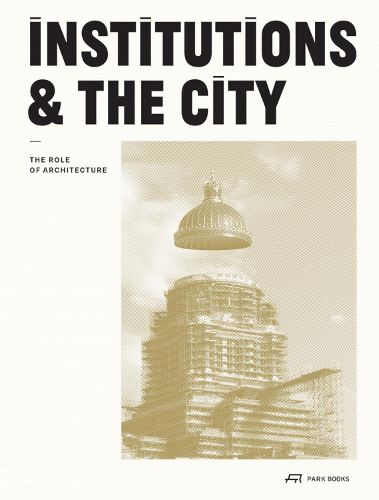Readings Newsletter
Become a Readings Member to make your shopping experience even easier.
Sign in or sign up for free!
You’re not far away from qualifying for FREE standard shipping within Australia
You’ve qualified for FREE standard shipping within Australia
The cart is loading…






Institutions - the state, the church, the army, the judiciary, the university, the bank, etc.- organise social relations. As social structures, they regulate societies according to various practices, rites and rules of conduct, and guide our actions by delimiting what is possible and thinkable. Institutions’ individual scope depends on how the society as a whole understands them. They are in perpetual mutation and thus form complex entities. Architecture plays an essential role in the establishment, identification and perpetuation of this social structure as it formalises value systems in space and represents ideologies in permanent physical structures. Architecture establishes and reveals the way an institution functions through different strategies. Institutions and the City investigates this role of architecture, taking the Trace Royal (King’s Street) in Brussels as an example. Running from the Place Royale in the heart of the city to the Eglise Royale Sainte-Marie in the Schaerbeek district north of it, it is the place where several of Belgium’s national political, legal, religious, financial, and cultural institutions are located. The book explores the stratagems put in place over time by the various institutions to inscribe themselves durably on the country’s social order, and reveals similar spatial responses and surprisingly common mutation processes. And it highlights the importance of architecture when it comes to inventing new relationships with institutional spaces in order to live together better in a time when social, political and cultural reference points are being blurred. Text in English, French and Dutch. AUTHORS: Gerald Ledent is co-founder of Brussels-based architecture firm KIS studio and a professor at the Faculty of Architecture, Architectural Engineering, and Urban Planning, Catholic University of Louvain (UCLouvain).
Cecile Vandernoot is an architect and writer. She pursues her PhD and works as teaching assistant the Faculty of Architecture, Architectural Engineering, and Urban Planning, Catholic University of Louvain (UCLouvain). SELLING POINTS: . A ground-breaking study of architecture’s role in the establishment, identification, and perpetuation of public institutions that shape and structure societies and the life of individuals . Presents the results of a three-year research project at the Faculty of Architecture, Architectural Engineering, and Urban Planning (LOCI), UCLouvain . Features essays by leading scholars that are organised around architectural drawings and collages produced by LOCI students, including previously unpublished archival documents, maps and engravings 148 colour, 85 b/w illustrations
$9.00 standard shipping within Australia
FREE standard shipping within Australia for orders over $100.00
Express & International shipping calculated at checkout
Institutions - the state, the church, the army, the judiciary, the university, the bank, etc.- organise social relations. As social structures, they regulate societies according to various practices, rites and rules of conduct, and guide our actions by delimiting what is possible and thinkable. Institutions’ individual scope depends on how the society as a whole understands them. They are in perpetual mutation and thus form complex entities. Architecture plays an essential role in the establishment, identification and perpetuation of this social structure as it formalises value systems in space and represents ideologies in permanent physical structures. Architecture establishes and reveals the way an institution functions through different strategies. Institutions and the City investigates this role of architecture, taking the Trace Royal (King’s Street) in Brussels as an example. Running from the Place Royale in the heart of the city to the Eglise Royale Sainte-Marie in the Schaerbeek district north of it, it is the place where several of Belgium’s national political, legal, religious, financial, and cultural institutions are located. The book explores the stratagems put in place over time by the various institutions to inscribe themselves durably on the country’s social order, and reveals similar spatial responses and surprisingly common mutation processes. And it highlights the importance of architecture when it comes to inventing new relationships with institutional spaces in order to live together better in a time when social, political and cultural reference points are being blurred. Text in English, French and Dutch. AUTHORS: Gerald Ledent is co-founder of Brussels-based architecture firm KIS studio and a professor at the Faculty of Architecture, Architectural Engineering, and Urban Planning, Catholic University of Louvain (UCLouvain).
Cecile Vandernoot is an architect and writer. She pursues her PhD and works as teaching assistant the Faculty of Architecture, Architectural Engineering, and Urban Planning, Catholic University of Louvain (UCLouvain). SELLING POINTS: . A ground-breaking study of architecture’s role in the establishment, identification, and perpetuation of public institutions that shape and structure societies and the life of individuals . Presents the results of a three-year research project at the Faculty of Architecture, Architectural Engineering, and Urban Planning (LOCI), UCLouvain . Features essays by leading scholars that are organised around architectural drawings and collages produced by LOCI students, including previously unpublished archival documents, maps and engravings 148 colour, 85 b/w illustrations